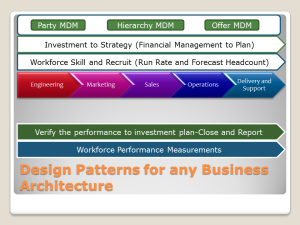Management Activities
All management activities must consider the people component of the process; which decisions people make and the outcome of their decisions. People are managed by managers who have the accountability for their people and they way their effort impacts the companies overall performance.
Business Process Activity
The objective in this section of this article tells us the people to process activity that insights should be derived from. A business process decision.
A business process step or square box equals a person, action or cost for effort and a dependency with another functional group in cases of decisions.
Truth Statement
A”truth statement” about the performance measures across two organizations in the business process model.
The following diagram highlights the connections across two functions; in an expense transaction capability we begin with an investment planned or sale that must be fulfilled for a customer. Our purchasing department enables the request by accepting the request “as is”.
- If not accepted, the process returns to the requester for re-work.
If accepted, the purchase order would be created and transmitted to the supplier. Another cross functional activity with an external stakeholder, another point of measurement. Did our supplier perform as expected based on the predefined process?
Performance Measurement
Any cross functional hand-off must be measured by input and output with the diamond representing a management activity that an employee would be measured for outcomes of their decision.
An example;
- How many times can purchasing accept the purchase request “as is”?
- Does this return to requester task reduce the purchasing departments effectiveness?
For this reason, any enterprise insight or management report must include the steps saved in the delivery of such insights. What am I saying? The great results from insights often becomes realized in the form of a report.
Two different data sources may be connected in ways that the process remains and people effort may appear to be corrected when in fact only the report was changed.
This seems like a great opportunity to me as a Lean and Design for Six Sigma minded person. I love to re-engineer business processes. People love to perform work that adds value.
Otherwise you are presenting half the picture, you haven’t factored the cost nor reduced the effort people are performing for no reason. This has been the single biggest failure in the world of reporting without any visibility into the operational performance.
If you are reporting outside the applications people use to perform the activity in a process, you are introducing lower value for the audience that should be measured for severity by the number of rows in a table.
Multiply by a person and assume the savings for the person to stop performing low value work if the information meets the business management reports by omission of information or connecting places that weren’t connected earlier.
Whenever you see a diamond you should assume capture of an input concludes with a decision. Report or BI=each column in a process performance measure would be captured and retained for electronic record purposes.
A person inputs a decision; diamond decision in a workflow to output a column in a table or schema by the number of rows
- Each Row in a performance report; ie…the values in the rows column=equals an output from a person acquire person effort time
- In my opinion, a process = a series of steps that must be sequenced to input a desired output.
- I cannot think of a single example where the process isn’t sequenced; one assumes the process sequence in every organization may be named and slightly differ by industry.
- Maturity in Business Process would assume every maturity has no opportunity to break this business expectation.
By design the current challenge we face, seems to be helping raise the vital impact to the bottom line with these types of nuances being mis-applied via technology forums.






















